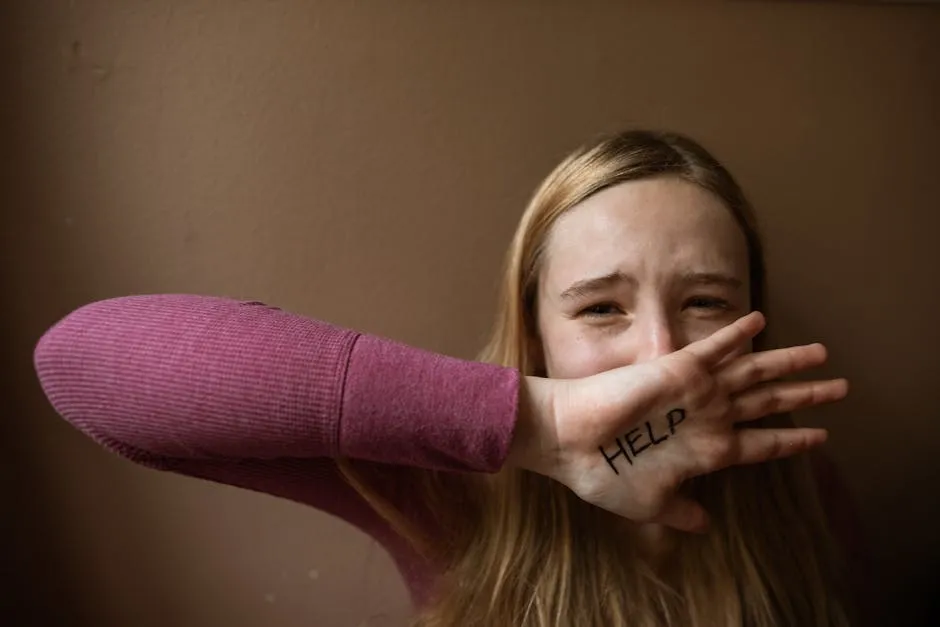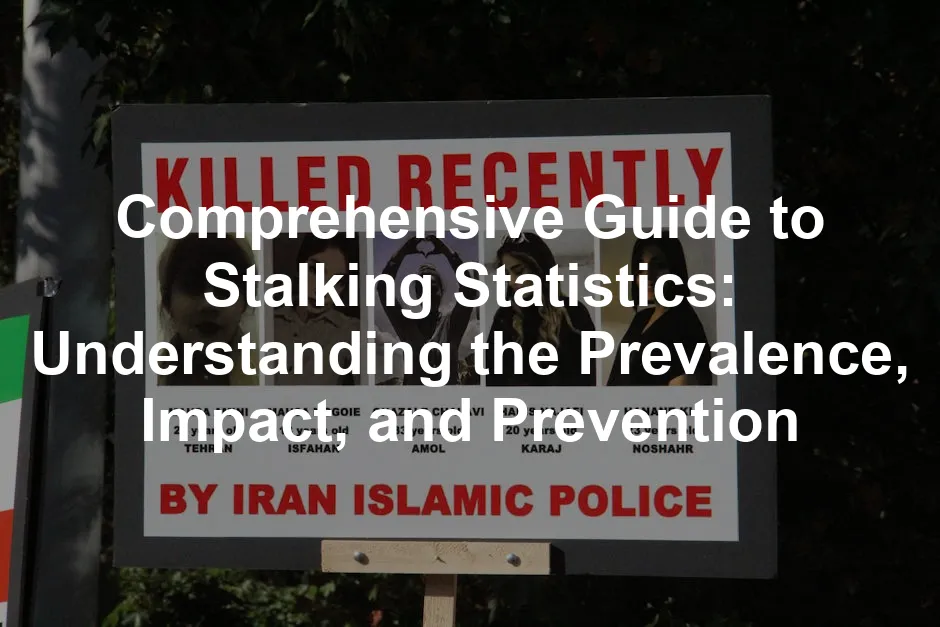Introduction
Stalking isn’t just a plot twist in a thriller movie; it’s a genuine public safety concern. Millions of people face this troubling reality every day. Stalking can happen to anyone, regardless of age, gender, or background. It can manifest in various forms, including traditional stalking and the increasingly prevalent cyberstalking.
Understanding stalking statistics is vital. Why? Because awareness is the first step to prevention. By examining the chilling facts and figures, we can better grasp the scope of the issue. It’s not just numbers; these statistics represent real lives impacted by fear and anxiety.
In this article, you’ll learn what constitutes stalking, common behaviors associated with it, and the critical statistics that paint a clearer picture of its prevalence. We’ll also explore the emotional and psychological toll it takes on victims. So, buckle up! We’re about to unravel the complex world of stalking.

What is Stalking?
Definition of Stalking
Stalking is a pattern of repeated, unwanted behaviors directed at an individual. The Centers for Disease Control and Prevention (CDC) defines it as actions that cause a person to fear for their safety. The Stalking Prevention, Awareness, and Resource Center (SPARC) echoes this sentiment, emphasizing that these behaviors can lead to substantial emotional distress.
Common traits of stalking include fixation, obsession, and a clear intent to harass. It’s essential to recognize that stalking isn’t just about physical following; it often involves digital harassment as well. According to various studies, stalkers typically know their victims, with many being former partners, friends, or acquaintances.

Common Stalking Behaviors
Stalking can take many forms, and the methods can be unsettling. Typical stalking behaviors include:
- Repeated calls, texts, or emails.
- Following the victim or showing up at their home, work, or school.
- Monitoring the victim’s activities through technology.
- Leaving unwanted gifts or messages that create fear or anxiety.
With the rise of technology, stalking behaviors have evolved. Cyberstalking is now a common tactic, involving unwanted digital communication, online harassment, and tracking through GPS or spyware.
Recognizing these behaviors is crucial for anyone who suspects they might be a victim. Awareness is the first step in seeking help and protection. Armed with this knowledge, we can take action against stalking and support those affected.

Consider enhancing your personal safety with a Personal Safety Alarm Keychain. This handy device can emit a loud sound to alert others in case of danger, ensuring you feel safer when out and about.
The Prevalence of Stalking
National Stalking Statistics
Stalking is a widespread issue affecting millions in the U.S., with staggering statistics that paint a grim picture. According to the Centers for Disease Control and Prevention (CDC), approximately 1 in 3 women and 1 in 6 men have experienced stalking at some point in their lives. These figures are not just numbers; they signify the reality that many people live in fear every day.
The statistics reveal a stark gender divide. For women, 15% have reported being stalked, compared to 6% of men. Moreover, the nature of stalking varies across genders. Female victims are more likely to be stalked by intimate partners, with 60% indicating that their stalker was a current or former partner. In contrast, 44% of male victims report similar circumstances.
The numbers also indicate that stalking often occurs early in life. More than 50% of female survivors and over 30% of male survivors were first stalked before they turned 25. This highlights a disturbing trend where young people are particularly vulnerable, facing a higher risk of stalking than their older counterparts.

Understanding the statistics surrounding stalking is essential for awareness and prevention. For a deeper dive, check out an introduction to statistical learning with python book length.
Demographics of Stalking Victims
Stalking does not discriminate; it affects people across various demographics, but certain groups are at higher risk. Young individuals, especially those aged 16 to 24, are significantly more likely to be targets. In fact, 8.8% of individuals in this age group reported experiencing stalking in the past year. This statistic underscores the need for heightened awareness and protective measures for younger populations.
Gender plays a crucial role in stalking experiences. Women are disproportionately affected, making up 78% of stalking victims. However, it’s essential to note that men also face stalking, with reports indicating that nearly 22% of male victims have experienced stalking. Additionally, LGBTQ+ individuals often experience stalking at higher rates, exacerbating the vulnerability of these communities.
The intersection of other factors, such as race and socioeconomic status, also influences stalking experiences. Victims from marginalized groups may face additional challenges in seeking help, emphasizing the importance of tailored resources and support systems to address their unique needs.

International Perspectives on Stalking
Stalking is not confined to the U.S.; it’s a global issue. In Australia, statistics reveal that 1 in 5 women and 1 in 15 men have experienced stalking since age 15. This aligns with findings from the Crime Survey for England and Wales, which indicates that 1 in 7 people aged 16 and over have been victims of stalking at least once. Women and younger individuals are most commonly affected in these regions as well, reflecting a global trend.
The Crime Survey for England and Wales reported that around 1.5 million people experienced stalking in the year ending March 2024. Interestingly, 42% of victims reported that their stalking involved online harassment, illustrating the increasing prevalence of digital stalking methods.
These international statistics not only highlight the commonality of stalking across different cultures but also reveal the urgent need for global awareness and effective preventive measures. Countries are beginning to recognize stalking as a significant public safety issue, prompting discussions around legal reforms and victim support services.
Overall, the prevalence of stalking is a chilling reminder of the fear many individuals face daily. Understanding these statistics can empower communities to better address the issue, support victims, and foster safer environments for all. By shining a light on stalking, we can contribute to a culture that prioritizes safety and well-being, ensuring that no one has to suffer in silence.

Stalking Victims and Perpetrators
Victims of Stalking
Stalking is a pervasive issue that affects individuals across various demographics, primarily women. A staggering 78% of stalking victims are female, while 22% are male. The age range of victims spans from preteens to seniors, but young adults aged 16 to 24 are particularly vulnerable. In fact, 8.8% of individuals in this age group report experiencing stalking annually.
Emotional and psychological impacts on victims can be profound. Many victims report feelings of fear, anxiety, and depression. According to the National Intimate Partner and Sexual Violence Survey, nearly 69% of female victims and 80% of male victims experienced threats of physical harm during their stalking ordeal. This sense of fear can lead to long-lasting mental health issues, including post-traumatic stress disorder (PTSD) and chronic anxiety. Victims often describe their lives as being controlled by someone else, leading to feelings of isolation and helplessness.
The psychological toll extends beyond immediate fear. Victims frequently experience sleep disturbances, paranoia, and agoraphobia. A study found that 84% of victims report feeling constantly on edge. The emotional burden can disrupt daily life, leading to job loss, social withdrawal, and strained relationships. This cycle of fear and distress is a critical reminder of the need for support systems and resources for victims.

To combat these feelings, consider reading “The Body Keeps the Score” by Bessel van der Kolk. This book delves into how trauma affects the body and mind, providing insights for recovery and healing.
Who Are the Perpetrators?
Stalking is predominantly perpetrated by individuals known to the victim. More than 80% of survivors report that their stalker was someone they knew, such as an ex-partner or an acquaintance. For female victims, over 60% are stalked by current or former partners, while 44% of male victims report similar circumstances. The dynamics of these relationships often create a complex web of emotional entanglement, making it more challenging for victims to escape their situations.
When examining the gender dynamics of stalkers, it’s notable that 87% of perpetrators are male. In contrast, 48% of male stalking survivors report being stalked by another male, whereas nearly 45% report being stalked by females. This shows that stalking can occur within various relationship contexts, including intimate partnerships and casual acquaintances.
Moreover, stalking often intersects with other forms of violence, particularly intimate partner violence. The correlation is alarming: 40% of stalking victims are targeted by intimate partners, indicating that stalking can be a precursor or component of more severe abuse.

The Role of Technology in Stalking
Technology has revolutionized the way stalking is perpetrated. Cyberstalking, a form of technology-facilitated abuse, is on the rise. Statistics indicate that a staggering 80% of stalking victims experience some form of cyberstalking. This includes unwanted communications through texts, social media messages, and emails.
Recent data shows that between 6.5% and 41% of individuals may experience cyberstalking at some point in their lives. In 2019 alone, about 1.5 million people aged 16 or older were victims of cyberstalking. The prevalence of digital methods, such as GPS tracking and spying software, has made it easier for stalkers to invade their victims’ privacy.
The anonymity provided by the Internet can embolden stalkers, making it harder for victims to identify or confront them. Moreover, the emotional impact of cyberstalking can be just as severe as traditional stalking, contributing to feelings of fear, helplessness, and anxiety. With technology evolving, so too must our understanding of stalking and the resources available to help those affected.

To enhance your personal security in this digital age, consider investing in a GPS Tracker for Personal Safety. This handy device can help you keep tabs on your whereabouts and ensure that you always have a way to alert someone if needed.
The Impact of Stalking on Victims
Stalking isn’t just a nuisance; it’s a serious violation that wreaks havoc on the lives of its victims. From emotional turmoil to financial strain, the effects can be devastating. Let’s break down the multifaceted impact of stalking on individuals.

Psychological Effects
The psychological consequences of stalking can be profound. Victims often experience heightened anxiety, depression, and symptoms of post-traumatic stress disorder (PTSD). Imagine living in constant fear, unable to escape the shadow of someone who refuses to respect your boundaries.
Research indicates that nearly 69% of female victims and 80% of male victims report experiencing threats of physical harm. This sense of danger can lead to debilitating mental health issues. A staggering 84% of stalking victims report feelings of fear. The emotional toll is immense, with many victims grappling with insomnia, paranoia, and severe anxiety.
Statistics further underline this impact. Studies reveal that 58% of female victims and 49% of male victims experienced stalking before they turned 25. This early exposure can set the stage for long-term mental health struggles. Victims may find themselves haunted by their experiences, leading to a cycle of fear that disrupts daily life.
The trauma inflicted by stalking is not merely temporary. Many victims suffer from long-lasting psychological effects, with studies showing higher rates of chronic anxiety and depression compared to the general population. The emotional scars can linger, affecting relationships, work, and overall quality of life.

For those looking for a way to cope, consider exploring “The Gift of Fear” by Gavin de Becker. This book provides invaluable insights into recognizing and responding to dangerous situations.
Social and Economic Consequences
Stalking doesn’t just invade the mind; it spills over into every aspect of a victim’s life. Socially, victims often withdraw from friends and family, fearing for their safety. The isolation can be suffocating. Over 50% of victims report that they have curtailed or stopped work due to stalking, highlighting the economic burden stalking can impose.
Financially, the repercussions can be devastating. Victims may face legal fees, counseling costs, and even lost wages from missed work. A study from the National Intimate Partner and Sexual Violence Survey found that stalking victims often experience job loss or reduced productivity, exacerbating their financial woes.
The stress of dealing with a stalker can also lead to decreased work performance. Victims report difficulties concentrating, increased absenteeism, and a general decline in job satisfaction. This can create a vicious cycle where financial insecurity heightens anxiety, pushing victims deeper into distress.

Legal Outcomes and Reporting
Despite the severe consequences, stalking often goes unreported. Many victims are hesitant to approach law enforcement, fearing disbelief or further victimization. In fact, less than a third of stalking victims actually report their experiences to the police. The reasons vary, but a significant barrier is the perception that stalking is a trivial issue or that law enforcement won’t take it seriously.
The legal framework surrounding stalking is inconsistent across states. While all 50 states have laws against stalking, definitions and penalties can differ greatly. Many victims find navigating this system daunting. The bureaucratic red tape can deter them from seeking justice, leaving them feeling powerless.
Moreover, stalking is often intertwined with other forms of domestic violence. Victims of intimate partner stalking are at greater risk of physical harm, yet the legal responses can be inadequate. Understanding their rights and available protections becomes crucial for victims looking to reclaim their lives.
In summary, the impact of stalking is far-reaching. Victims endure psychological, social, and economic consequences that can last a lifetime. Raising awareness and fostering robust support systems can help mitigate these effects and empower victims to seek the help they deserve.

Prevention and Support for Victims
Resources for Victims
When faced with stalking, resources can be a lifeline. Organizations provide critical support and guidance to help victims reclaim their lives. One significant resource is the National Stalking Advocacy Service, which offers advice and assistance. Their hotline, 0808 802 0300, is a safe space for victims to share their experiences and seek help.
Another vital organization is Safe Horizon, which provides resources for victims of stalking and domestic violence. Their website offers a wealth of information about coping strategies, legal protections, and local services.
Awareness campaigns play a pivotal role in supporting victims. Initiatives like National Stalking Awareness Month encourage communities to recognize stalking signs and offer support. These campaigns help destigmatize victim experiences, fostering an environment where individuals feel safe seeking help. It’s essential for communities to rally around victims, creating a network of understanding and compassion that can significantly impact their recovery.

To further enhance your safety, consider a Pepper Spray Self Defense tool. This compact solution offers a sense of security, allowing you to defend yourself in threatening situations.
Prevention Strategies
Preventing stalking is a shared responsibility. Individuals can take proactive steps to protect themselves. One effective measure is to maintain a low profile on social media. Limiting personal information shared publicly can deter potential stalkers. Regularly updating privacy settings and being cautious about friend requests are also smart strategies.
Safety planning is another critical step. This might involve varying daily routines, avoiding predictable patterns, and sharing plans with trusted friends or family. Having a safety plan can give victims a sense of control and empowerment.
Communities also play a significant role in prevention. Local organizations can host workshops and seminars to educate residents about stalking and its warning signs. Schools can implement programs that teach students about healthy relationships and respect for boundaries. These preventative measures can create a culture that discourages stalking behaviors.
Legislative efforts are crucial too. Advocating for stronger stalking laws and increased penalties can deter potential offenders. Communities must work together to push for legal reforms that better protect victims.

Legal Protections and Advocacy
Legal protections for stalking victims vary significantly by jurisdiction. In the U.S., all states have laws against stalking, but the definitions and penalties differ. For instance, some states classify stalking as a felony after a single incident, while others require multiple events. Victims should familiarize themselves with local laws to understand their rights.
Many states offer restraining orders to protect victims. These orders can legally prohibit the stalker from contacting or approaching the victim. If violated, the perpetrator can face criminal charges. However, navigating this legal landscape can be daunting for victims, emphasizing the need for accessible legal resources.
Advocacy groups are working tirelessly to improve stalking laws and victim support services. Organizations like the Stalking Prevention, Awareness, and Resource Center (SPARC) are at the forefront of these efforts. They provide resources, support, and guidance to both victims and lawmakers, aiming to create a more comprehensive legal framework for stalking cases.
Victims must know they are not alone. With the right resources and supports, they can find their voice, reclaim their lives, and contribute to a safer community for everyone.
FAQs
What should I do if I think I’m being stalked?
If you suspect you’re being stalked, document all incidents. Keep a record of dates, times, and descriptions. Contact local law enforcement and reach out to a support organization for guidance.
How can I protect myself from becoming a victim of stalking?
Be proactive in safeguarding your personal information online. Consider implementing privacy settings on social media and be cautious about sharing location details. Trust your instincts; if someone makes you uncomfortable, take steps to distance yourself.
Are there specific laws regarding stalking in different states or countries?
Yes, stalking laws vary widely by location. Each state has its own legal definitions and penalties for stalking. It’s essential to familiarize yourself with local laws to understand your rights and protections.
What are the psychological effects of being stalked?
Victims often report severe emotional distress, including anxiety, depression, and post-traumatic stress disorder (PTSD). Many experience a persistent sense of fear, impacting daily life and relationships.
Additional Resources
For more information and support, consider these resources:
- National Stalking Helpline: 0808 802 0300
- Stalking Prevention, Awareness, and Resource Center: SPARC Website
- Safe Horizon: Safe Horizon Website
- 1800RESPECT: 1800 737 732 (Australia)
And if you’re interested in understanding more about the psychology behind these behaviors, grab a copy of “The Psychology of Stalking” by J. Reid Meloy. This insightful book can help shed light on the behaviors and motivations behind stalking.
Please let us know what you think about our content by leaving a comment down below!
Thank you for reading till here 🙂
All images from Pexels




